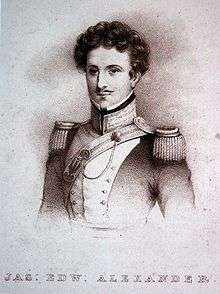James Edward Alexander

Major-General Sir James Edward Alexander KStJ CB FRSE FRGS[1] (16 October 1803 – 2 April 1885) was a Scottish soldier, traveller and author.
Alexander was the driving force behind the placement of Cleopatra's Needle on the Thames Embankment.[1]
Background
Born in Stirling,[1] he was the eldest son of Edward Alexander of Powis, Clackmannanshire, and his second wife Catherine Glas, daughter of John Glas.[2] He received his training in Edinburgh, Glasgow, and the Royal Military College, Sandhurst.
In 1837 he married Eveline Marie Mitchell.
He died in Ryde on the Isle of Wight but is buried in Old Logie Churchyard just east of his home town of Stirling.[3]
Military career
In 1820, he joined the British East India Company's army, transferring into the British Army in 1825. As aide-de-camp to the British envoy to Persia, he witnessed fighting during the war between Persia and Russia in 1826 and in 1829 was present in the Balkans during the Russo-Turkish War, 1828-1829. From 1832 to 1834, he witnessed the War of the Two Brothers in Portugal, and in 1835 he took part in the 6th Cape Frontier War in South Africa as aide-de-camp and private secretary to Sir Benjamin d'Urban. He was the son-in-law of Charles Collier Michell, having married in Cape Town on 25 October 1837 his daughter Eveline Marie, born 16 April 1821.
In 1838, he was made a Knight Bachelor for his services.[2] From 1841, he served in Canada, among others in the staff of Sir William Rowan. During the Crimean War, he commanded the 14th Regiment of Foot as lieutenant-colonel in the Siege of Sevastopol in 1855[2] and held an important command during the Land Wars in New Zealand in 1862. He retired from active service in 1877 and on 1 July 1881 was given the honorary rank of general.[4]
Explorer
On behalf of the Royal Geographical Society (which he had co-founded), he conducted an exploring expedition into Namaqualand and Damaraland, lasting from 8 September 1836 to 21 September 1837, in the course of which he collected rock specimens, pelts of rare animals, birdskins, weapons and implements from the Herero and Nama, as well as drawing maps of the region and making a first list of Herero words. Subsequently Arrowsmith made use of his data to draw a map accompanying his book of the expedition. Alexander Bay on the Orange River mouth, is named after him. In 1877, he was largely responsible for the preservation and transfer of Cleopatra's Needle to England.
Works
- Travels from India to England: comprehending a visit to the Burman empire, and a journey through Persia, Asia Minor, European Turkey, &c. In the years 1825-26. – London : Parbury, Allen, & Co, 1827
- Travels through Russia and the Crimea. (1830, 2 vols.)
- Transatlantic Sketches: comprising visits to the most Interesting Scenes in North & South America & West Indies. 2 vols. – London : Richard Bentley, 1833
- Sketches in Portugal during the Civil War of 1834. – London : J. Cochrane & Co, 1835
- Narrative of a Voyage of Observation among the Colonies of Western Africa, in the Flag-Ship Thalia; and of a Campaign in Kaffir-Land, on the Staff of the Commander-in-Chief in 1835. 2 vols. – London : Henry Colburn, 1837
- Expedition of discovery into the interior of Africa : Through the Hitherto Undescribed Countries of the Great Namaquas, Boschmans, and Hill Damaras, Performed under the Auspices of Her Majesty's Government and the Royal Geographic Society. 2 vols. – London : Henry Colburn, 1838
- Life of Field Marshal, His Grace the Duke of Wellington : Embracing His Civil, Military, and Political Career to the Present Time. 2 vols. – London : Henry Colbourn, 1839–40
- L'Acadie : or Seven Years' Explorations in British America. 2 vols. – London : Henry Colburn, 1849 (online: vol.1, vol.2)
- Passages in the life of a soldier, or, Military service in the East and West. – London : Hurst & Blackett, 1857
- Salmon-Fishing in Canada by a Resident. – London und Montreal : Longman, Green, Longman, and Roberts, 1860
- Incidents of the last Maori-War in New Zealand. – London : Richard Bentley, 1863
- The Albatross : record of voyage of the "Great Britain" steam ship from Victoria to England in 1862. – Stirling : C. Rogers & Co., 1863
- Bush Fighting. – London : Sampson, Low, Marston, Low & Searle, 1873
- Cleopatra's Needle, the obelisk of Alexandria (1879)
References
-
 This article incorporates text from a publication now in the public domain: Chisholm, Hugh, ed. (1911). "Alexander, Sir James Edward". Encyclopædia Britannica (11th ed.). Cambridge University Press.
This article incorporates text from a publication now in the public domain: Chisholm, Hugh, ed. (1911). "Alexander, Sir James Edward". Encyclopædia Britannica (11th ed.). Cambridge University Press.
- 1 2 3 Waterston, Charles D; Macmillan Shearer, A (July 2006). Former Fellows of the Royal Society of Edinburgh 1783-2002: Biographical Index (PDF). I. Edinburgh: The Royal Society of Edinburgh. ISBN 978-0-902198-84-5. Retrieved 8 December 2011.
- 1 2 3 Dod, Robert P. (1860). The Peerage, Baronetage and Knightage of Great Britain and Ireland. London: Whitaker and Co. p. 87.
- ↑ http://www.royalsoced.org.uk/cms/files/fellows/biographical_index/fells_indexp1.pdf
- ↑ The London Gazette: no. 25085. p. 1215. 17 Mar 1882.
- ↑ IPNI. J.E.Alexander.